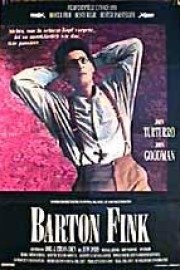Barton Fink
This is only the second time I’ve watched the Coen Brothers’s Cannes winner, “Barton Fink,” and I understand it a lot more than I did the first time, and yet, I find it as baffling as any other Coen movie before or since. This isn’t the straight-forward Coen storytelling of “Fargo” or “A Serious Man,” but something more unusual and opaque, like “The Big Lebowski” and “No Country for Old Men.” Like those films, “Barton Fink” feels like a simple narrative, but it has imagery and ideas that are distinctively the work of Joel and Ethan Coen, and somehow work within the context of the larger story. That doesn’t mean it makes sense, but it does mean that the brothers behind “Raising Arizona” and “O Brother Where Art Thou?” have some mischievous tricks up their sleeves.
“Barton Fink” was written at a time when the Coens were struggling with the narrative of their 1990 crime drama, “Miller’s Crossing”; they wouldn’t call it “writer’s block” so much as a need to step away from “Miller’s Crossing” for a spell and refocus their energies. The resulting film, “Barton Fink,” is the sort of offbeat writer’s project that would come from such a moment, and indeed, it is about a playwright from New York who is seduced by the money in Los Angeles to write scripts, and finds himself stuck. The Coens will not claim that “Barton Fink,” set in 1941, is indicative of their experiences in Hollywood, but it’s very true to the concept of a “tortured artist,” who searches for truth in his work, with anything less being deemed unacceptable. One of the great things about the Coens’s best films (“Fargo,” “No Country for Old Men,” “The Big Lebowski,” “True Grit”) is not that they are sharp, cohesive works narrative (although all but “Lebowski” are), but that there’s a fundamental truth at work in each film that shines through, even in the most ridiculous scenarios. Usually, this is tied to the central characters of each film, whether it’s a solitary lead (as in “Fargo” and “Lebowski”) or a group of main characters, as in “No Country” or “True Grit.” The same is true for the films below these, with “Barton Fink” especially sticking out in the titular character, played by the terrific John Turturro.
The film is more than a one-person show, however, with special notice required for John Goodman’s Charlie Meadows, an insurance salesman who is in the room next to Barton’s at the Hotel Earle, which appears to be all but deserted, though plenty of shoes are left outside the doors of the rooms on the same floor Barton is staying on. (As Chet, the chipper front desk man played by Steve Buscemi says, shoe shining is one of the hotel’s perks for guests.) Charlie is a good-natured guy who takes a liking to Barton immediately, and the two form a bit of a friendship, although Barton seems more interested in working than talking, even though Charlie, with his “common man” air about him and working class job, does provide some inspiration for Barton when he finds himself stuck trying to write a wrestling picture for a producer (Michael Lerner’s Jack Lipnick, one of the other vivid supporting roles in the film) who is enamored with capturing that “Fink quality.” Another producer, Tony Shalhoub’s Ben Geisler, suggests finding another writer to talk about to get an idea of how to write the movie, but when he meets a literary hero in W.P. Mayhew (John Mahoney) and his “secretary” (Judy Davis’s Audrey Taylor), he has some of his expectations shattered not only by Mayhew’s incessant drinking, but also a revelation by Audrey shortly before she is found brutally murdered in Barton’s bed.
The film is set in 1941, and the Coen Brothers are absolutely in love with creating that period in Hollywood (with a nod to 1940’s New York and Broadway at the beginning) on-screen. This was their first time working with cinematographer Roger Deakins, and the way his images are lit provide an interesting contrast- sometimes, the lighting plays up a natural feel for the locations and sets, while other times, pointing towards something more sinister and uneasy, which is especially true in the Hotel Earle sequences. The Coens list Kubrick’s “The Shining” as an influence for the film, and in narrative and look, that very much comes through, in particular during a sequence near the end where Barton’s life becomes, almost literally, apocalyptic. It’s one of the most bizarre sequences in any Coen Brothers film, and it’s one where the film seems to fly off the rails and into a writer indulging their most absurd impulses. From a thematic standpoint, I would suppose it makes sense, but it still left this viewer reeling given how controlled and focused the film is before that moment about the struggles of an artist to create his art, and elevate something that someone else sees as silliness into a meaningful exploration of the truths of life, which we have seen is Barton’s goal.










